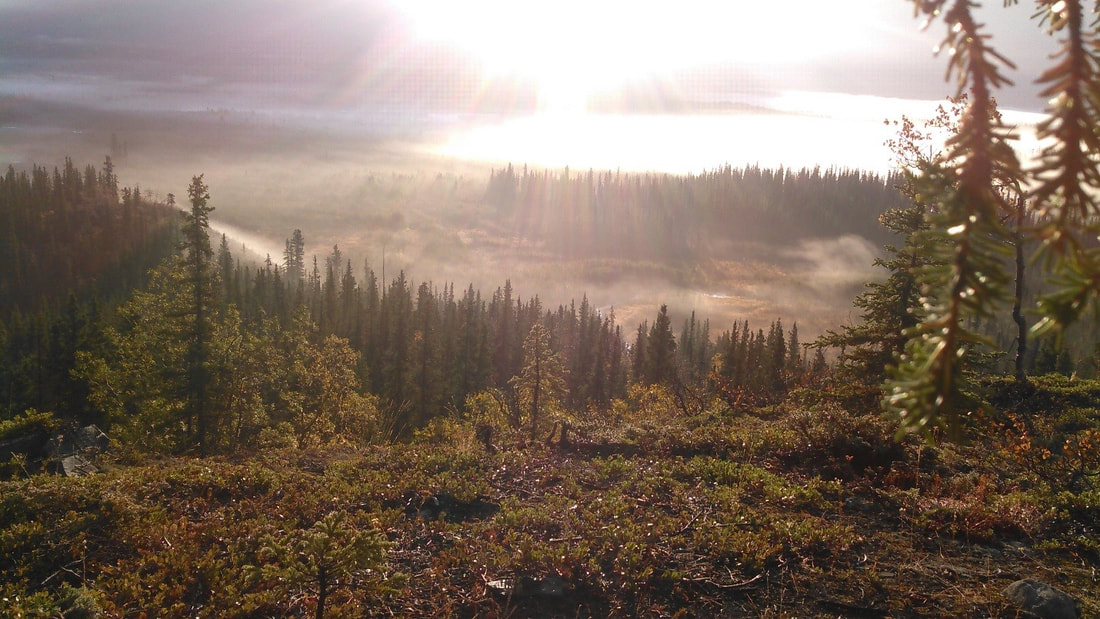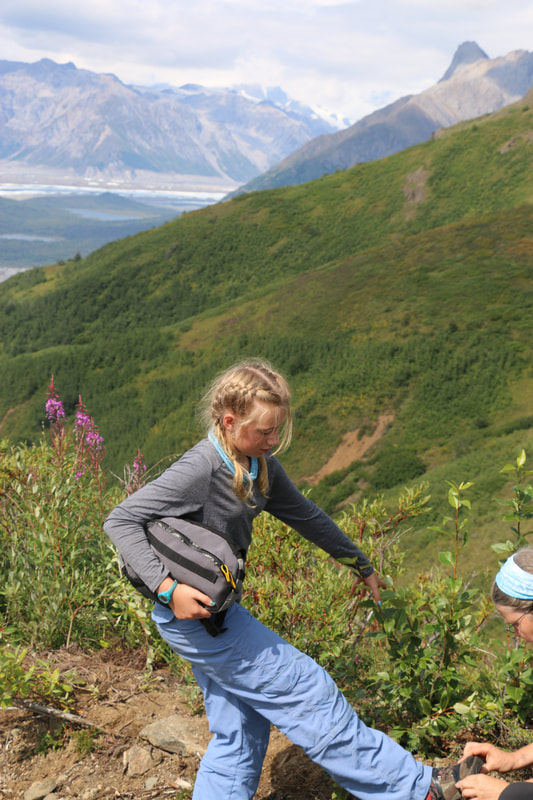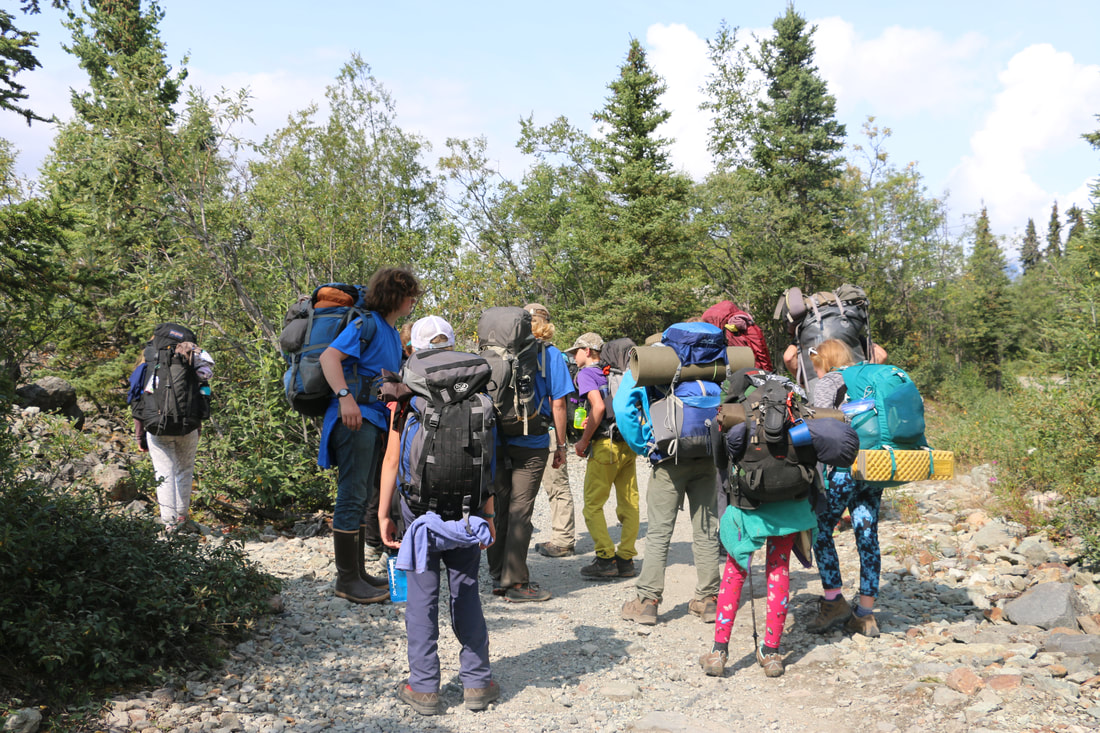|
Copper River Record October 24, 2019 By Robin Mayo Sitting tucked under the wide branches of a spruce tree, we are bundled against the early morning chill and prepared with thermos mugs of coffee, binoculars, and bear spray. This is the perfect spot to see out across the valley at first light. Halfway up the mountainsides, a layer of wispy clouds is sailing upriver at a steady pace. At river level, fog is rising from the ponds and sloughs and drifting slowly downriver. It catches on hillocks and patches of spruce, piling up briefly before being combed into strands and continuing to drift close to the surface. Several hundred yards below us, we harvested a moose in a small meadow in the bend of a slough. We have spent the last three days field dressing, hauling, and hanging the moose on a high pole. All looking forward to watching the gut pile, backbone, and head left behind. A Gray Jay arrived soon after we did, bravely flitting nearby and hauling off any beak-sized tidbit it could pull loose. Surely word has spread among the ravens, magpies, and eagles already. Bears and wolves will not be far behind. Nothing will be wasted. The fog is thickening as a few rays of sun start to reach the ground, well soaked by a night of rain. Soon the valley floor is fully carpeted, only a few ghostly outlines of the tallest spruce trees are visible. I am struck by how slow and subtle yet complete every change in the fog is. You cannot really see movement, but within a few minutes everything is transformed. The air and water are interacting under a complex set of rules: temperature, sun, dew point, breeze, topography. The fog drifts slowly down valley at ground level, but as it lifts to the level of the upriver breeze it is caught and sails with that current. It is okay to be moving in different directions at different levels, I remind myself. It is okay to live within conflicting values, habits, and cultures. My partner eats meat and potatoes, frosted mini wheats with milk. I also like things like asparagus, couscous, and feta cheese. This bothered me at first, but now I smile, privately pleased to eat a whole avocado at one sitting without guilt. The coffee is no longer enough, I have started to think about the four potatoes and one onion that we carried up yesterday evening. The only part of the moose that didn’t get hauled downriver is the ragged end of one of the backstraps. Once the fog is totally gone I’ll go make breakfast. If you cut the potatoes in irregular chunks they won’t stick together as they fry. I’ll wait to add the onion, so the potatoes will have time to get perfectly brown on every side. The meat I will cut across the grain in finger-shaped steaks to roll in seasoned flour then fry hot and fast. An eagle arrives but does not approach the gut pile, watching for ten minutes from the top of a dead spruce. A magpie swoops in to check us out, keen eye locked on our hiding place as he cocks his head to and fro, wondering who we are trying to fool. The fog has gathered itself for another act in the morning drama. It is draped across the valley, some places thick as a blizzard, others thin so the layered silhouettes of ridgelines show. The camera on my phone proves to be totally inept, so I content myself with admiring the way shafts of sun cut between tall spruce, sending rays to the ground. Surely news of this bounty has spread through the valley on the breezes and scavengers are converging, waiting and watching until the smell of our piss fades and they deem it safe to approach. The big bull had an old wound on one hind leg, a thick hard mass of scar tissue all the way around the bone with three puncture wounds that never fully healed, deep pockets of grainy pus ringed with bare skin. At some point a wolf or bear had hold of that leg, but he kicked free. Ten minutes ago the fog looked ready to lift and burn off for good, but the air has gone still now and clumps linger in spite of the direct rays of the sun. The warmth reaches in to our hiding place, welcome on chilled fingers and toes. Ignoring the rumble of my stomach, I wait patiently while pillows soften to shrouds, which dissolve into tufts, which slowly fade. The spell is over. I gather my coffee mug and straighten stiff legs. Walking back to camp, I decide to save half of the onion for stir-fry moose tomorrow. Morning sun cuts through the morning fog at Moose Camp Robin Mayo photo
1 Comment
Copper River Record October 10, 2019 By Robin Mayo I carry a zippered blue nylon bag wherever I go, hoping I don’t need it. It is an oddly shaped bag of forgotten origin, about ten inches square with a zipper on three sides and mesh pockets. This bag is transferred from day pack to backpack to dry bag dozens of times each season. Inside is a first aid kit, extra matches and lighters, spare headlamp and batteries. Latex gloves and empty Ziplock bags. Birch bark, wax paper, and the stub of a red candle for firestarter. A reflective bivvy sack that doubles as a small tarp. A small notebook, pencil, and first aid manual. Bandaids and Ibuprofen so I don’t have to dismember the first aid kit every time someone gets a boo-boo. Tiny bottles of Aquamira water treatment and a bug headnet in its own tiny stuff sack. Most of these items are never used. I check them in the spring, replace crushed pills and tattered ziplocks, then tuck them back away again and forget about them. I subscribe to the philosophy of preparedness that believes the better prepared, the less likely you are to encounter misfortune, much as packing raingear seems to help the rain stay away. But there is one item that comes out nearly every trip, sometimes every day. In fact, the contents of this tiny purple stuff sack are currently spread out on my bunk as I contemplate a tear in the hood of my raingear, which was brand new less than a week ago. I left it hanging on a nail outside the cabin and apparently an annoyed bear came along while we were gone for the day and tore it down. I’m glad there were no granola bars in the pockets or the whole thing would surely be shredded. The only scar is an inch-long tear on the hood where it parted company with the nail. The tiny purple bag contains cord and string in various weights, dental floss and sewing thread, an assortment of sewing needles, a little tube of superglue, extra toggles and buckles, and safety pins fastened to the hem of the bag. There is black Gorilla Tape for repairing dry bags and backpacks. I’m momentarily confused by the absence of a roll of electrical tape, then remember giving it to my daughter as she fashioned impromptu dog booties for Echo, limping with a split paw. For this job I’ll definitely be using Tenacious Tape, an adhesive-backed ripstop nylon perfect for patching raingear and puffy jackets. Usually there is a set of shoelaces, but we’ve raided these to make croakies for our eyeglasses after twice halting all progress to crawl around on the ground looking for lost spectacles. What, no duct tape? I can hear your disbelief from here. At the risk of sounding like a bad Alaskan, I’ll confess I am not a fan of the stuff. It doesn’t hold up very well, and leaves behind a sticky, stringy mess. The most important part of the repair kit actually lives in my pocket, a tiny multi-tool that almost universally draws coos from women and dismissive snorts from men. This is actually the second mini-tool, I snapped the pliers on the first one while helping build a bridge. In spite of this being obviously outside of the design scope of the tool, the manufacturer replaced it without question. The teensy scissors on the multi tool are very sharp, perfect for cutting a rounded patch out of Tenacious Tape for my rainjacket hood. First I need to re-stitch the seam in the drawcord channel. I’m interested to see that no waterproofing was added when the seam was originally sewn. The dental floss I use sets deeply in the dense rubber fabric, forming a satisfying seal. Then I line up and lay flat the jagged edges of the tear, and smooth on the oval of bright yellow repair tape. It’s probably not necessary, but I put a matching patch on the inside as well for good measure. Good as new, and now with a story to tell. I repack the repair kit, making a note to replace the roll of electrical tape when I get home. A student first introduced me to the wonders of this stuff on one of WISE’s geology backpacking trips, strapping on the flapping sole of a hiking boot. Electrical tape doesn’t always stick super well to some materials, but it has a great combination of toughness and stretchiness that make it great for certain repairs. Since blowing out hiking boots has become a Geology Camp tradition, I took note and added it to standard repair kit stock. The little multi-tool goes back in my puffy jacket pocket, where it’s weight will be reassuring. The tiny purple stuff sack goes into the “Just in Case” bag, which fits nicely into the bottom of my day pack, just in case. Madison Carlton’s hiking boot gets emergency repairs on Bonanza Mine Trail during Geology Camp.
Copper River Record October 3, 2019 By Robin Mayo “After a certain point, it’s mostly about the cuisine,” claimed Steve, as our party settled into camp on a small river in Utah. Awed by the desert landscape, I disagreed, but not strongly enough to refuse the king crab and steak on my plate. “We just eat dirty rice,” said Ruth with a shrug when I asked her for backpacking recipes. “Why bother? You are out in the wilderness, anything tastes good.” When it comes to camping food, most of us will come in somewhere between these two extremes. I don’t care too much as long as it is warm and filling, but imagining the good food that will reward me has gotten me through many a hard day of backpacking. This fall I had the chance to try some freeze-dried meals for the first time in over 30 years. Although they have improved (Thank Goodness!) I still found the food disappointing, especially considering the premium price. My biggest beef: most of them don’t re-hydrate very well if you just add hot water to the pouch per the instructions. They work much better if you put all the ingredients in a pot and simmer them gently, which is starting to sound a lot like cooking. In which case, why am I cooking $9 Mountain House instead of $1.79 Kraft? Even a small supermarket like our IGA in Glennallen is a fantastic source of light, tasty, quick cooking and economical staples for any sort of outdoor adventure, from car camping to multi-day backpacking. Here then are my top-ten favorites for outdoor cuisine. I’m assuming you are already acquainted with instant oatmeal, boxed mac-n-cheese, swiss miss, beef jerky, and the overwhelming assortment of bars available. #1- Instant Mashed Potatoes. Honestly, this stuff is magic. Many foods claim to be instant, but this really does transform from a few spoonfulls of powder to a bowl of yummy taters with just warm water and a little stirring. Also super handy for thickening recipes gone wrong. #2- Nut Butters. Surely that $3 little plastic jar of Jif is one of the best bargains around for protein, calories, and sheer comfort. As well as classic sandwiches, it is excellent added to oatmeal or ramen soup. Trust me, just try it. If PB isn’t your thing, try Sunbutter or one of the many other choices. #3-Convenience Packed Dairy Products. Normally I avoid single-serving anything, but string cheese, Go-Gurt, and little tubes of cream cheese are awesome for camping, saving you much spoiled food and many messes. A tube or two of cream cheese is the secret for transforming box mac-n-cheese into something extraordinary. #4- Flat Breads. Flour Tortillas and Pita Bread travel much better than loaves. As well as creating lunch wraps, they can be warmed for quesadillas or pizzas. If you want slightly less flat bread that holds up to packing, try bagels, which also make pretty good candle holders. #5- Foil Packed Protein. Tuna, chicken, salmon, and other ready-to-serve meats add satisfying protein and flavor. We rinse out the pouches so the garbage doesn’t become a bear attractant. #6- Stove Top Stuffing. My Mom would NEVER serve stove-top stuffing at home, but she loves to bring it camping. Lots of flavor, reconstitutes in a moment, and true to it’s name, really good at stuffing the crevices when you still feel hollow after a meal. #7- Deli Meats. Some carnivores are content to go nearly vegan while camping, but I really crave meat. Thinly sliced pepperoni, salami layered with cream cheese, or summer sausage hacked into chunks with a pocket knife are infinitely satisfying, and have enough salt and nitrates to keep without refrigeration. #8-Dried Fruits. Excellent for keeping one regular as well as satisfying a sweet tooth without mainlining pure sugar. Check the ingredients though, did you know Craisins contain more sugar than cranberries? #9-Minute Rice. As promised, it makes very acceptable rice with just a minute of boiling, at a fraction of the price of freeze dried. A staple that makes the base of many meals. #10-Coconut Milk Powder. This magic ingredient will not be found in every supermarket, you may have to track it down online. Works great as coffee creamer and milk substitute, and has transformative power when added to nearly any sweet or savory creation. Here are some recipes to get you started. Thanksgiving Dinner: This is my go-to meal for large groups. Each person makes it just how they like it in their cup or bowl, so no large pots are needed and special diets are easily accommodated. Mix up and simmer a packet of Turkey Gravy for each 4 diners. In individual cups or bowls, place ¼ cup of dry instant mashed potatoes and a spoonful of stove-top stuffing. Reconstitute with water and mix well. Add foil pack chicken and craisins, then top with hot gravy. Repeat as many times as necessary until everyone is full. When packing for this meal, disregard the suggested serving size on the mashed potatoes, just pack a lot. If there are teenagers involved, pack even more. Chicken Curry: I’ve never had a kid dislike this, even if they say they don’t like, or have never had, curry. Cook ½ cup minute rice per person according to box directions. Add some extra water, a spoonful of dried coconut milk, and a spoonful of peanut butter per person. Add curry powder to taste and mix very well. Add foil-pack chicken and mix gently. Pita Pizza: Layer Pita bread with Pizza Sauce (put it in a squeeze mayonnaise or jam bottle for easy packing and dispensing) pepperoni or other toppings, and grated mozzarella cheese. Warm in an oiled pan with a lid, add a few drops of water on the side to make steam and melt the cheese. Still hungry? I’ll give you a bonus for this top-ten list. Drumroll please…..Jell-O No-Bake Cheesecake! If you tend towards the “Steve” or gourmet end of the camp-cook spectrum, find and appropriate receptacle of approximately pie-pan dimensions, and layer the ingredients according to instructions. You’ll need to bring some butter for the crust, and dry milk for the filling. You have an impressive and delicious treat or backcountry birthday cake. If you are more of a practical “Ruth” type, put the contents of all the pouches in a ziplock bag, add water, and knead until combined. Snip off the corner of the bag and dispense directly into mouths. You’re welcome and Happy Backcountry Cooking! Nothing builds up an appetite like carrying a heavy pack! Geology Camp 2019, WISE Photo
|
Who We AreWISEfriends are several writers connected with Wrangell Institute for Science and Environment, a nonprofit organization located in Alaska's Copper River Valley. Most of these articles originally appeared in our local newspaper, the Copper River Record. Archives
August 2021
Categories
All
|
|
WISE is a
501(c)3 nonprofit organization |
Contact Us |





 RSS Feed
RSS Feed
